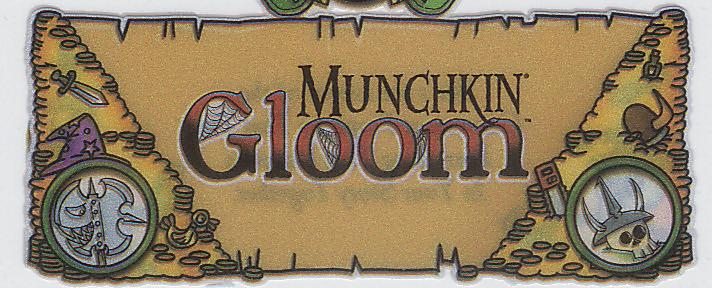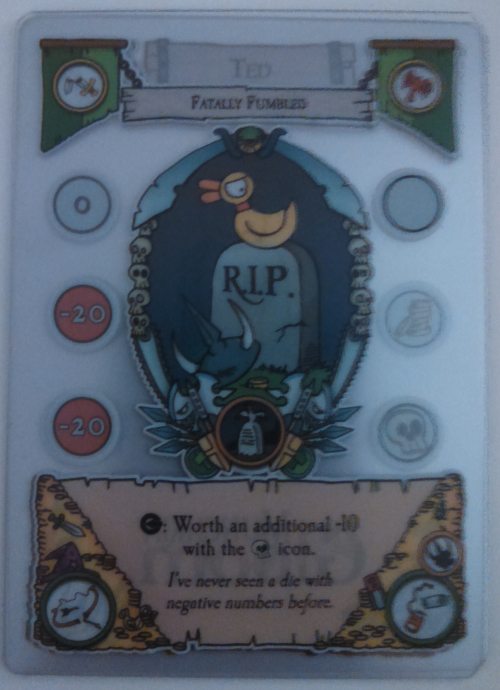
Atlas Games’ storytelling card game Gloom and Steve Jackson Games’ Munchkin have both been around since the early 2000s, gaining fans and introducing expansions. This summer, they came together in Munchkin Gloom.
To be clear: The box looks and feels like Munchkin – it features John Kovalic’s art; it shares the dimensions of Munchkin packaging; and it’s portrait-oriented, unlike the landscape-oriented art on other Gloom sets. But this is Munchkin-themed Gloom, not the other way around. (If this has a familiar ring, it could be because this was the second Munchkin-mixer I encountered at Gen Con this year, the other being Smash Up Munchkin.)
At eleven years old, Gloom is actually a few years older than GeekDad(!), so I’ll review the game play and goals, since it doesn’t seem like we’ve ever discussed it in detail.
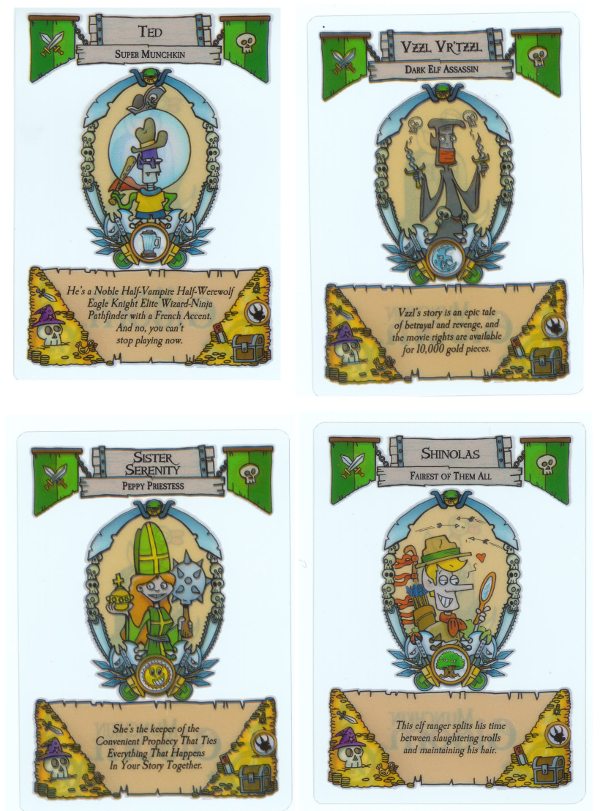
Each Munchkin Gloom player controls a party of characters. There are four parties to choose from: Heroes, Villains, Wild Bunch, and Blenders. There are no unique attributes or advantages to any of them: In game play terms, one party is the same as another. Your goal is to make your own party members as miserable as possible – as measured in negative Self-Worth points – before guiding them to an Untimely Death. At the same time, you can cheer up the other players’ characters. The game ends when all of the characters in one player’s party are dead. (That person isn’t necessarily the winner – more on the scoring in a bit.)

In two- and three-player games, each player will use all five character cards in their party. If you’ve got four players, everyone just uses four characters to keep the game shorter. And if you want to play with five people, you just build a fifth party with the four “misfits” removed from the other parties.
Everyone sets their characters face up in front of them. You’ll be playing on everyone’s decks, so it’s important that all players can see and reach each other’s cards. Because Gloom cards are printed on clear plastic and we were using a table with a busy woodgrain pattern, we found it easier to read the cards when everyone had a plain sheet of white paper to put them on. This also had the added benefit of making it possible to pencil in point totals near characters for quick reference.
After removing the two rules reference cards and any unused characters, you shuffle the deck and deal everyone five cards face-down. The remaining deck becomes the draw pile. Leave room for a discard pile next to it. The player who had the worst day goes first.
A turn consists of two actions, followed by drawing cards. There are five possible actions:
- Play an Event card which has an immediate effect, then discard it.
- Play a Modifier card on a living Character to alter that character’s Self-Worth
- Play an Untimely Death card on a Character that has a negative Self-Worth – a key point here is that Untimely Death cards can only be played as the first action of a turn, unless you have a specific card that says otherwise
- Discard your entire hand
- Pass your action
Once you’ve taken your action(s), you draw your hand back up to five cards, and that’s the end of your turn.
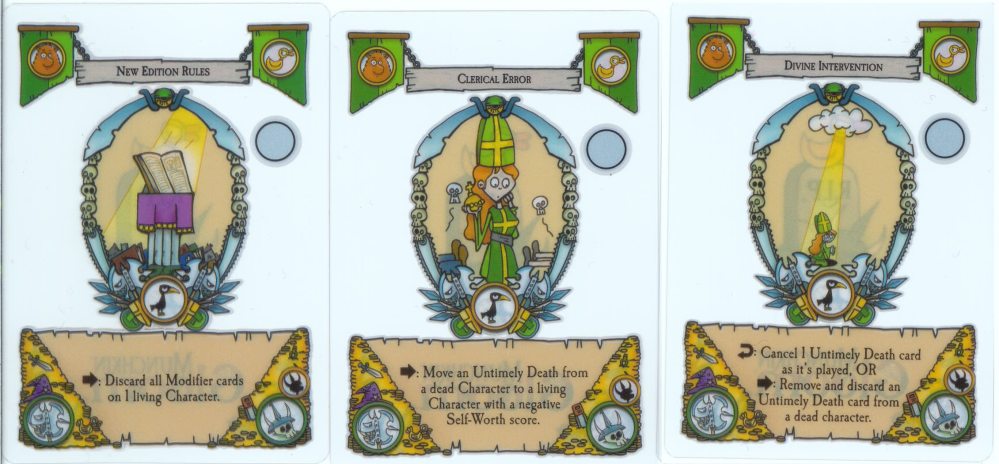
It’s a pretty simple mechanic, really: You’re trying to lower your Characters’ Self-Worth as much as possible before knocking them off with Untimely Death cards, and you’re trying to keep your opponents from doing the same thing.

The game ends immediately when all of the Characters in one party are dead. When this happens, everyone adds up the Self-Worth scores of only their dead characters, and the winner is the player with the lowest total – the one who has succeeded in making their party the most miserable.
What makes Gloom unique as a card game is that the cards are printed on transparent plastic, with variations in opaque areas. As the game goes on, and cards are stacked, different Self-Worth values, card effects, and story icons will be concealed or replaced. The cardinal rule of Munchkin Gloom is that you only pay attention to what you can see.
For example, consider Ted, a member of the Blenders party:
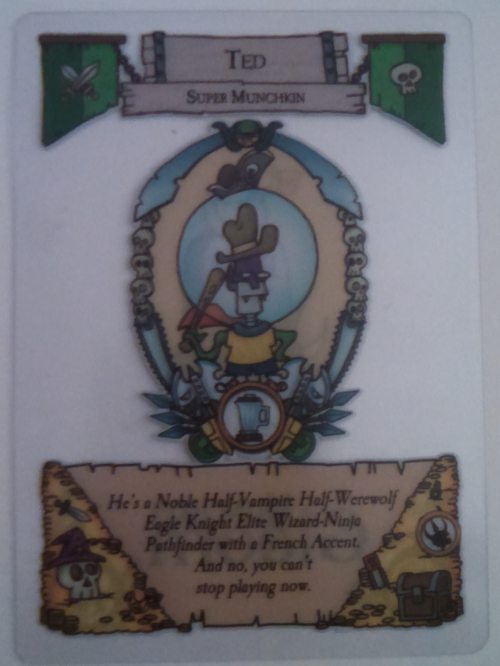
If Ted’s in your party, you’d be pleased to know that Ted was Aggravated by Armor, lowering his self-worth by 15 points, as indicated by the figure in the red dot on the card played right on top of Ted’s character card:
Now, if you’re overseeing one of the other parties, you might “feel bad” for Ted, so you cut him a break and say, “Oh, look – Ted Saw the Scenario” – which would give him an edge in an RPG, of course. That’s going to boost his self-worth by 20 points, as indicated by the figure in the black dot:
Ted’s now at a total Self-Worth of plus five!
Unfortunately for Ted – but fortunately for his player – it looks like the next thing he did was Anger Something Ancient, resulting in -40 points to his self-worth.
And now that Ted’s sufficiently gloomy, his player decides it’s a fine time for a Fatal Fumble of the dice:
Barring any post-mortem interference, dead Ted’s going to earn his player -50 points: negative forty for the points in the red dots, and another negative 10-point bonus thanks to the skull icon from a previous card, which is still visible over there on the right side.
At its core, you can play Munchkin Gloom as a straight-up numbers-and-strategy game, enhanced by the humor of the RPG tropes and humorous flavor text. Munchkin Gloom includes cards like “Rules Lawyer” (cancel and discard someone else’s event when it’s played) or “Whine to the GM.” Positive cards – which, remember, are bad in this game, since they increase Self-Worth – include things like “Took a Teammate’s Treasure” and “Paid for the Pizza.” Gaming and adventure wordplay, silliness, tropes, and references are in full force here, in character names, flavor text, and alliterative events, so definitely take the time to appreciate the writing. And Kovalic’s art is always a treat.
It all works well together, and it’s fun.
But Munchkin Gloom also encourages storytelling with each card play: So when you play the “Contracted a Curse” on Shinolas (the elf ranger who splits his time between slaughtering tolls and maintaining his hair), you’re encouraged to share just how that happened. (Me? I’d go with a bad batch of sculpting gel or a hairbrush carved from a lich bone.)
I like that creator Keith Baker wanted something more than just Gloom dressed up in Munchkin armor: There’s a good interview at the Steve Jackson Games website where he talks about modifying some of the game mechanics to make this game a bit Munchkin-esque in play as well as in its appearance:
“One of the critical things that defines Munchkin is backstabbing your friends. Gloom isn’t designed with this sort of interactive treachery in mind. I compensated for this by shifting a lot of traditional Gloom effects to hurt other players . . . so an effect that would be “Draw 2 cards” in traditional Gloom is “Draw 2 cards from the hand of the player to your right” in Munchkin Gloom. The other effect is Events that are automatically triggered when you draw them, which is a way to bring in some of the chaos of curses from classic Munchkin.”
As with both Munchkin and Gloom, you’ll need to be the judge of whether the gallows humor is age-suitable for your kids. If you want to check it out, Atlas Games has a full list of the cards online. The box suggests ages 13 and up.
Strategy-wise, the game play itself boils down to numbers and taking advantage of timely deaths, and it’s a good mix of thinking, creative card play, and the luck of the draw. The rules even suggest teaching the game to younger players or beginners by ignoring the cards’ effect text and just tracking the characters’ Self-Worth.
I had only minor nitpicks with the component and packaging design:
The way the cards are printed, players can gain some measure of knowledge about them even when viewing just the cardback – so when someone gets to make a blind draw from another player’s hand, it’s advisable for the latter to hold their cards so that only the top edges are visible.
Also, the Munchkin-sized box is way more than is needed for storing the game’s 110 cards. The insert tray doesn’t keep the cards from slipping around if the box is stored vertically, and the tray design makes it difficult to remove the complete stacks.
Those things don’t detract from the overall enjoyment of the game, though. It seemed appropriate to introduce Munchkin Gloom to my Wednesday night RPG group one week when our gamemaster was out of town, and we had a lot of fun with it.
Disclosure: Atlas Games provided GeekDad with a review copy of Munchkin Gloom. Additionally, GeekDad Senior Editor Jonathan H. Liu is credited as one of the game’s playtesters.
